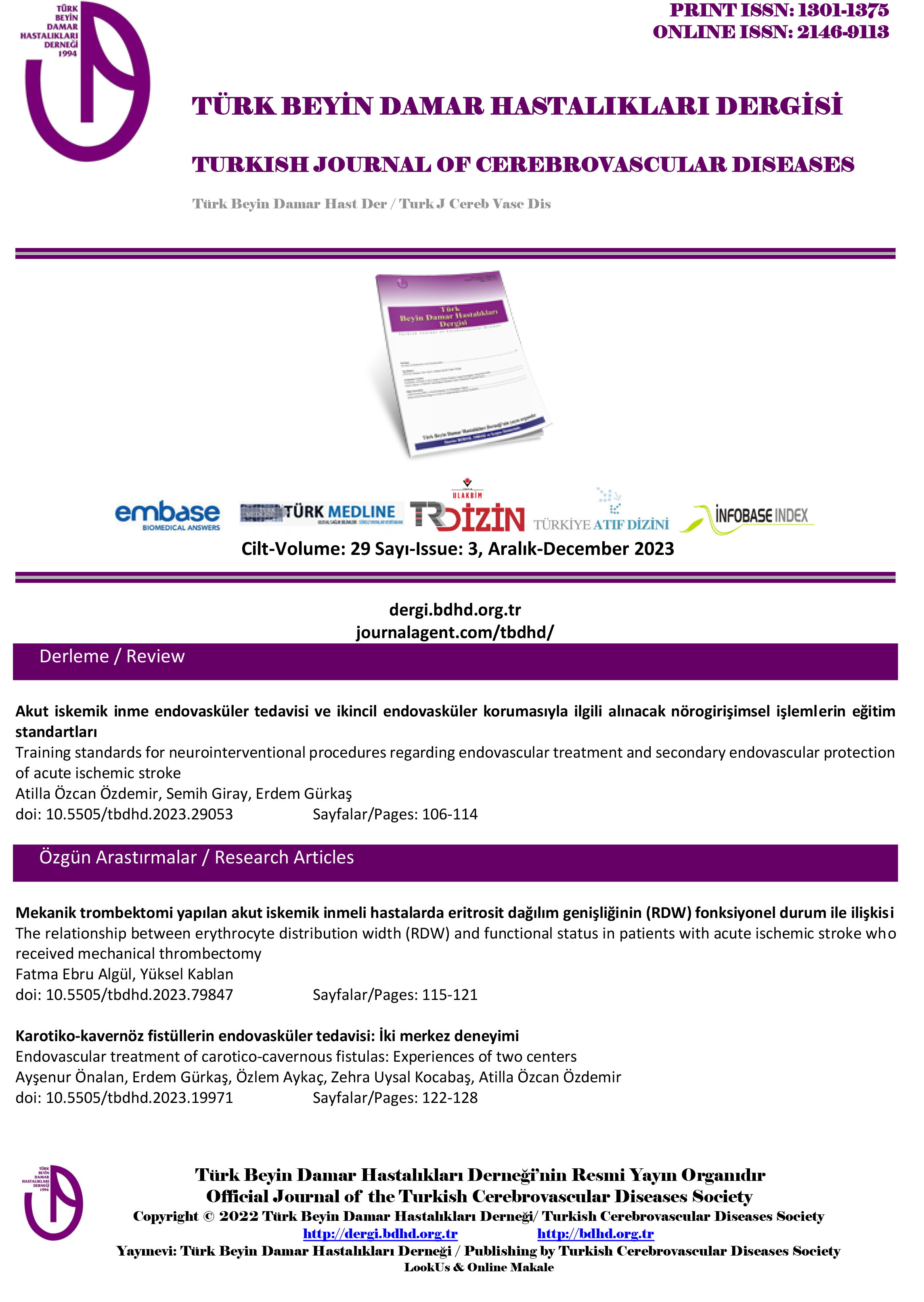Strokta rehabilitasyon progresyonunun bir belirleyicisi olarak, üst ekstremite somatosensoriyal uyarılma potansiyelleri
Ferhan Soyuer, Hülya Kayıhan, Abdullah Talasoğlu, Ali SoyuerErciyes Üniversitesi Tıp Fakültesi, Nöroloji Anabilim DalıGİRİŞ ve AMAÇ: Bu çalışmada, ilk kez stroke geçiren spesifik bir hasta grubunda, üst ekstremite somatosensoriyel uyarılma potansiyellerinin progresyondaki, belirleyici yönünün gösterilmesi amaçlanmıştır.
YÖNTEM ve GEREÇLER: Çalışmamıza, yatmakta olan, ilk kez serebral infarkt geçirmiş, akut stroklu 21 yetişkin (11 kadın, 10 erkek; yaş ortalamaları 57.1±10.2 yıl) olgu, kontrol grubu olarak da 21 sağlıklı kişi (9 kadın, 12 erkek; yaş ortalamaları 54.4± 9.4 yıl) alınmıştır.
Hasta grubu, motor (motricity indeksi), fokal yetersizlik (frenchay kol test ve dokuz delikli çivi test), spastisite (Ashworth skalası), duyu-algı-motor bütünlüğü (görsel, somatoduyu algıları ve motor performans), fonksiyonel düzey (fonksiyonel bağımsızlık ölçümü) ve her iki üst ekstremiteden yapılan, median sinir somatosensoriyel uyarılma potansiyelleri (SUP) ile stroke sonrası ilk hafta içerisinde ve 3 ay sonrasında değerlendirilmişlerdir. Kontrol grubuna ise, SUP yapılmıştır. Hasta grubundaki olgulara haftada 5 gün toplam 3 hafta, konvensiyonel fizyoterapi ve Bobath tedavi yaklaşımlı nörofizyolojik fizyoterapi uygulanmıştır.
BULGULAR: Çalışmanın sonucunda, her iki değerlendirme dönemindeki değerler arasındaki fark iyileşme yönünde istatistiksel olarak anlamlı bulunmuştur (p< 0.05). SUPlerinin farklı komponentleri ile motor, fokal yetersizlik, fonksiyonel bağımsızlık ölçümü ve duyu-algı-motor bütünlüğü gibi fonksiyonlar arasında istatistiksel olarak anlamlı bir ilişki gözlenmiştir (p<0.05). Normal SUPlerin fonksiyonel iyileşmeyle, önemli oranda ilişkili olduğu görülmüştür.
TARTIŞMA ve SONUÇ: Çalışma, stroklu olgularda SUPlerinin faydalı bir prognostik araç olduğunu göstermiştir. SUPlerinin duyu yollarının daha objektif bir ölçümünü sağlayabilmesi ve özellikle, disfazi, dikkat güçlüğü olan ve şuur seviyesi düşük hastalarda kullanım değeri olduğu görülmüştür. Bunun yanında nörolojik bozukluğun ciddiyeti ile korele olmuştur. Fakat etkilenmenin seviyesini göstermede yetersiz kalmaktadır. Bu nedenle fizyoterapi değerlendirmeleri halen fonksiyonel seviyeyi belirlemede önemli görülmektedir.
Upper limb somatosensory evoked potentials as a predictor of rehabilitation progress in stroke patients
Ferhan Soyuer, Hülya Kayıhan, Abdullah Talasoğlu, Ali SoyuerErciyes University Faculty Of Medicine, Department Of NeurologINTRODUCTION: The aim of this was to determine the predictive yield of upper limb somatosensory evoked potential in a specific population of patients with first stroke.
METHODS: Twenty one adult with acute stroke patients suffering from their first stroke (cerebral infarction) (11 women, 10 men; mean age 57.1± 10.2 years) who were hospitalized at the department of Neurology were included in the study. We compared our findings with the finding of 21 healthy persons (9 women, 12 men; mean age 54.4±9.4 years).
Motor ability (motricity index), focal disability (frenchay arm test and nine hole peg test), activities of daily living (functional independence measure), Ayres sensory integration (visual, somatosensory perceptions and motor performance), spasticity (ashworth scale) and bilateral somatosensory evoked potentials (SEP) to stimulation of median nerve were evaluated in all patients with the first week and 3 months after stroke onset.SEPs were also evaluated in control groups. Patients in study groups were treated with conventional physiotherapy and neurophychological physiotherapy with Bobaths concepts, 5 days per week, totally 3 weeks.
RESULTS: As a result of this study, significant improvement between the first and the second examinations was found (p<0.05). The relationship between different components of somatosensory evoked potentials and other functions such as motor, focal, functional independence, sensory integration were statistically significant (p<0.05). Normal SEP correlated highly with a good functional outcome.
DISCUSSION AND CONCLUSION: This study showed that SEP studies are a very useful prognostic tool in patients with cerebrovascular accident. SEP can provide a more objective measure of sensory patways and are particularly useful in patients with dysphasia, inattention or a decreased level of consciousness. However, SEP correlates well with the severity of the neurological deficits, but it does not predict the degree of improvement over time. SEP has only limited prognostic value, and physical therapy assessments are still an important tool for functional status.
Sorumlu Yazar: Ferhan Soyuer, Türkiye
Makale Dili: Türkçe










